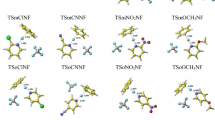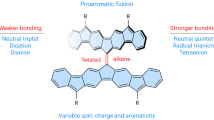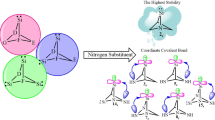Abstract
The geometries, energies, and electronic properties of the two possible configurations of bis-[dibenzo[a.i]fluorenylidene] were investigated theoretically by density functional theory DFT B3LYP at the UB3LYP/6-311 + G(2d,p) // UB3LYP/6-31 + G(d,p) level of theory. According to the performed calculations, it was found that the singlet is 3.4 kcal mol-1 lower in energy compared to triplet state at room temperature. This gap is compared with those of other alkenes like ethylene, (61.9 kcal mol-1) tetra-tert-butyethylene, (6.4 kcal mol-1) and bis-fluorenylidene (19.5 kcal mol-1). These results confirm the experimental findings of the paramagnetic properties determined by Franzen and Joschek. The low singlet-triplet gap in the case of bis-[dibenzo[a.i]fluorenylidene] is the result of a steric destabilization of the singlet due to strain and stabilization of the triplet electronic state by delocalization of each free electron within each aromatic moiety. This correlates with the special electronic structure of the triplet state of this compound, where facial interaction of two hydrogen atoms lying close to the lobes of each p-orbital occupied with a single electron at the distorted double bond in the triplet electronic state.

a) The singlet form of bis-dibenzo[a.i]fluorenylidene. b) The triplet form of bis-dibenzo[a.i]fluorenylidene. The central dihedral angle around the C=C double bond changes from 53.2° in the singlet electronic structure to 90.0° in the triplet electronic structure. Of great interest is the very low singlet-triplet gap of this electronic system which equals to 3.4 kcal/mol according to calculation by DFT UB3LYP/6-311+G(2d,p) // UB3LYP/6-31+G(d,p) level of theory.







Similar content being viewed by others
References
Liebman JF, Greenberg A (1976) A survey of strained organic molecules. Chem Rev 76:311–365
Lenoir D (1979) Force field calculations: e.g. strained alkenes. Nachr Chem Techn Lab 27:762–765
Sandström J (1983) Static and Dynamic Stereochemistry of Push-Pull and Strained. Ethylenes. Top Stereochem 14:83–181
Luef W, Keese R (1991) Strained Olefins: Structure and Reactivity of Nonplanar Carbon-Carbon Double Bonds. Top Stereochem 20:231–318
Lenoir D, Smith PJ, Liebman JF (2009) In: Dodziuk H (ed) Distorted Alkenes in Strained Hydrocarbons, Beyond the van’t Hoff and Le Bel Hypothesis. Wiley-VCH, Weinheim, pp 103–145
Lenoir D, Wattenbach C, Liebman JF (2006) Tetra-tert-butylethylene, fantasy, fake, or reality. Struct Chem 17:419–422
Sulzbach HM, Bolton E, Lenoir D, Schleyer PvR, Schaefer III HF (1996) Tetra-tert-butylethylene: An elusive molecule. J Am Soc 118:9908–9914
Kanawati B, Lenoir D, Schmitt-Kopplin P (2011) Can Tetra-tert-butylethylene be formed by ion–ion recombination or ion–molecule reaction of two di-tert-butylcarbene units?—a DFT study. J Phys Org Chem 24:83–91
Molins E, Miravitlles C, Espinosa BM (2002) 1,1‘,3,3‘,6,6‘,8,8‘-octachloro-9,9‘-bisfluorenylidene and Perchloro-9,9‘-bifluorenyldene. Two exceedingly Twisted Ethylenes. J Org Chem 67:7175–7178
Beck AH, Gompper R, Polborn K, Wagner HU (1993) Bi[1,3-bis(dicyanomethylene)indan-2-ylidene]—an ethylene derivative with extremely pronounced, twisting of the C=C bond. Angew Chem Int Ed Eng 32:1352–1354, See also ref. 27
Magidson OI (1925) Schliessung des Fluoren-Ringes in der Di-α-naphthyl-methan-Reihe. Ber Dtsch Chem Ges 58B:433–442
Bergmann ED, Fischer E, Hirshberg Y, Lavie D, Sprinzak Y, Szmuszkovicz J (1953) Fulvenes et ethylenes thermochromes. 26. Partie, Naphthofulvenes. Bull Soc Chim Fr 789-809
Bergman ED, Fischer E, Jaffe JH (1953) Exalted distortion polarization of some colored hydrocarbons. J Am Chem Soc 75:3230–3233
Franzen V, Joschek HI (1961) Zum Radikalcharakter des Bis-dibenzo[a.i]fluorenylidens. Liebigs Ann Chem 648:63–68
Schlenk W, Weichselfelder TH (1915) Zur Kenntnis des Hydrazins. Ber Dtsch Chem Ges 48:669–676
Montgomery LK, Huffman JC, Jurczak EA, Grendze MP (1986) The molecular structures of Thiele's and Chichibabin's hydrocarbons. J Am Chem Soc 108:6004–6011
McMasters DR, Wirz J (2001) Spectroscopy and reactivity of Kekulé hydrocarbons with very small singlet − triplet gaps. J Am Chem Soc 123:238–246
Wiberg KB, Hadad CM, Foresman JB, Chupka WA (1992) Electronically excited states of ethylene. J Phys Chem 96:10756–10768
Unett DJ, Caldwell RA (1995) The triplet state of alkenes: structure, dynamics, energetics and chemistry. Res Chem Intermed 21:665–709
Doering WvE, Roth WR, Bauer F, Breuckmann R, Ebbrecht T, Herbold M, Schmidt R, Lennartz HW, Lenoir D, Boese R (1989) Rotational barriers of strained olefines. Chem Ber 112:1263–1275
Sebastien V, Henrik O (2009) Aromaticity Changes along the Lowest-Triplet-State Path for C=C Bond Rotation of Annulenyl-Substituted Olefins Probed by the Electron Localization Function. J Phys Chem A 113:12304–12310
Apeloig Y (2011) Low-Coordination Silicon Compounds-Mechanistic Implications. The 13th European symposium of organic reactivity. Tartu, Estonia
Frisch MJ, Trucks GW, Schlegel HB, Scuseria GE, Robb MA, Cheeseman JR, Montgomery JA Jr, Vreven T, Kudin KN, Burant JC, Millam JM, Iyengar SS, Tomasi J, Barone V, Mennucci B, Cossi M, Scalmani G, Rega N, Petersson GA, Nakatsuji H, Hada M, Ehara M, Toyota K, Fukuda R, Hasegawa J, Ishida M, Nakajima T, Honda Y, Kitao O, Nakai H, Klene M, Li X, Knox JE, Hratchian HP, Cross JB, Bakken V, Adamo C, Jaramillo J, Gomperts R, Stratmann RE, Yazyev O, Austin AJ, Cammi R, Pomelli C, Ochterski JW, Ayala PY, Morokuma K, Voth GA, Salvador P, Dannenberg JJ, Zakrzewski VG, Dapprich S, Daniels AD, Strain MC, Farkas O, Malick DK, Rabuck AD, Raghavachari K, Foresman JB, Ortiz JV, Cui Q, Baboul AG, Clifford S, Cioslowski J, Stefanov BB, Liu G, Liashenko A, Piskorz P, Komaromi I, Martin RL, Fox DJ, Keith T, Al-Laham MA, Peng CY, Nanayakkara A, Challacombe M, Gill PMW, Johnson B, Chen W, Wong MW, Gonzalez C, Pople JA (2004) Gaussian 03, Revision C02. Gaussian Inc, Wallingford, CT
Foresman JB, Frisch A (1996) Exploring chemistry with electronic structure methods, 2nd edn. Gaussian Inc, Pittsburgh, PA
Marković S, Đurđević J, Jeremić S, Gutman I (2011) Triplet fluoranthenes: aromaticity versus unpaired electrons. J Mol Model 17:805–810
Beck AH (1993) Sterisch gehinderte Doppelbindungssysteme. Dissertation, Ludwig Maximilians Universität München
Polborn K, Private communication to Dieter Lenoir (2011)
Caldwell RA, Carlacci L, Doubleday CE, Furlani TR, King HF, McIver JW (1988) Viable geometries for T1-S0ISC in alkene triplets. J Am Chem Soc 110:6901–6903
Brink M, Möllerstedt H, Ottoson CH (2001) Characteristics of the electronic structures of diabatically and adiabatically Z/E-isomerizing olefins in the T1 state. J Phys Chem A 105:4071–4083
Nguyen MT, Matus MH, Lester WA, Dixon DA (2008) Heats of formation of triplet ethylene, ethylidene, and acetylene. J Phys Chem A 112:2082–2087
Mulliken RS, Roothaan CCJ (1947) The twisting frequency and the barrier height for free rotation in ethylene. Chem Rev 219–231
Qi F, Sorkhabi O, Suits AG, Chien SH, Li WK (2001) Photodissociation of ethylene sulfide at 193 nm: a photofragment translational spectroscopy study with VUV synchrotron radiation and ab initio calculations. J Am Chem Soc 123:148–161
Klein O, Hopf H, Grunenberg J (2009) The Ever-Elusive Tetra-tert-butylethene (TTBE, 3,4-Di-tert-butyl- 2,2,5,5-tetramethylhex-3-ene): Further Insight on Its Preparation. Eur J Org Chem 13:2141–2148
Akramine OE et al. (2003) Quantum Monte Carlo study of singlet-triplet transition in ethylene. J Chem Phys 3:1483–1488
Lee JS, Nyburg SC (1985) Refinement of the α-modification of 9,9-bifluorenylidene, C26H16. Acta Cryst C 41:560–567
Acknowledgments
We thank Dr. Kurt Polborn for his valuable comments on the x-ray structural data of compound 3. We thank Professor Yitzhak Apeloig for his helpful comments.
Author information
Authors and Affiliations
Corresponding authors
Electronic supplementary materials
Below is the link to the electronic supplementary material.
ESM 1
(DOC 42 kb)
Rights and permissions
About this article
Cite this article
Kanawati, B., Genest, A., Schmitt-Kopplin, P. et al. Bis-dibenzo[a.i]fluorenylidene, does it exist as stable 1,2-diradical?. J Mol Model 18, 5089–5095 (2012). https://doi.org/10.1007/s00894-012-1502-4
Received:
Accepted:
Published:
Issue Date:
DOI: https://doi.org/10.1007/s00894-012-1502-4




